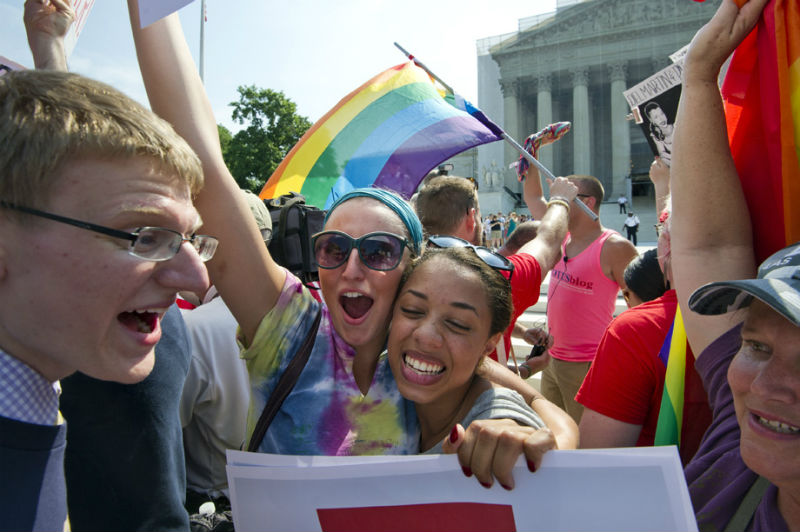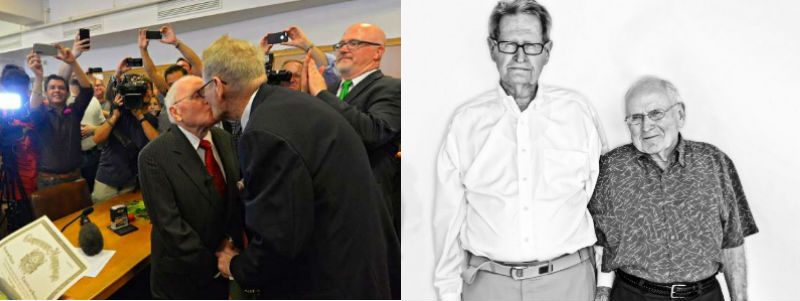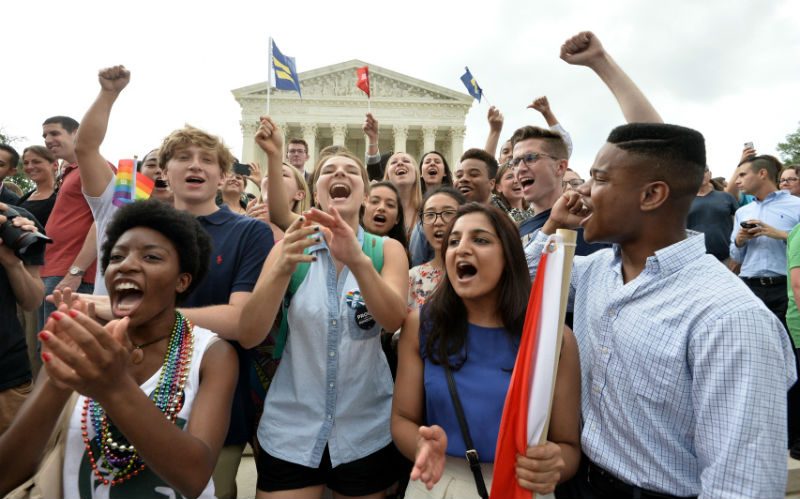What Equality Feels Like
In the week since the U.S. Supreme Court made same-sex marriage legal in America, there has been jubilation, celebration and some grumbling.
While this ruling doesn’t change the lives of every lesbian and gay man in America–although it has the potential to do so, should they decide to marry–it does represent a tectonic shift in both legal and social consciousness that many of us did not think we would ever see. And it is, I strongly believe, yet another in a series of civil rights dominoes to fall as history turns yet another page.
In 1986 as a young newspaper reporter, I was covering the Supreme Court. I would later be nominated for the Pulitzer Prize for my reporting and win several other journalism awards for that coverage. It was an exciting beat to cover and never more so than when I heard the arguments for Bowers v. Hardwick, the case that was supposed to end the sodomy laws against lesbian and gay Americans.
I sat behind those dark red velvet drapes in the press area to the left of the nine justices, my heart pounding. Bowers v. Hardwick was the first case to address the rights of lesbian and gay Americans and it was happening in front of me–a lesbian reporter. I am pretty sure I was the only gay person in the press box that day and as such the only one for whom those arguments could change my life and the lives of so many others.
And that case did change my life and that of millions of lesbians and gay men. But not for the better.
The court came down against us in that case with a vitriolic and hate-infused majority opinion by Justice Byron White. The precedent set then would not be overturned until 2003 in Lawrence v. Texas in an opinion written by Justice Anthony Kennedy who said, quite succinctly, that the high court got it wrong in 1986.
When Kennedy wrote for the majority in 2003, Justice Antonin Scalia said his ruling would open the door to legalizing same-sex marriage.
For once, Scalia was right.
Anticipation of the U.S. Supreme Court decision on marriage equality had been building for weeks. But no one could have anticipated that the high court would deliver their ruling on the eve of Pride weekend, on June 26, the anniversary of the beginning of the Days of Rage, the Stonewall Riots, the time when Stormé DeLarverie, a butch biracial lesbian, would throw the first punch with police that would change history forever as it spurred the crowd to action.

June 26th
The June 26 ruling by the SCOTUS was all we had hoped for. The 5-4 decision with its beautiful and eloquent majority opinion written by conservative justice Anthony Kennedy in Obergefell v. Hodges made for The Best Pride Ever. This year, along with the usual leather, feathers and non-stop rainbow flags, there were also marriages.
Lots and lots of marriages.
Lesbians and gay men, long denied the equal protections of the 14th Amendment of the U.S. Constitution in so many things, finally got one they’d been fighting for decades: marriage equality.
The U.S. is now the most populous nation with marriage equality.
Outside the U.S. Supreme Court, lesbians and gay men stood in the heat and blazing sun, waiting for the moment when their lives would change. Young couples, older couples, couples with children–their anxiety over how the court would rule turned to jubilation and tears of joy once the decision was announced.
The celebration in Washington translated to marriages throughout the country within hours of the SCOTUS decision.
Jack Evans, 85, and George Harris, 82, together for 54 years, were the first gay couple to wed in Dallas, Texas, shortly after the ruling.

Who wouldn’t cry at that wedding?
In Ann Arbor, Michigan, Marge Eide, 77, and Ann Sorrell, 78, also married right after the ruling. The couple had been together 43 years. Eide told Michigan reporters the two women had been watching the news and said there was no hesitation to get married once she learned about the decision. Eide told reporters, “Why would we wait? We’ve waited 42 years and eight months for this.”
These two couples represent one aspect of the deprivation, segregation and isolation lesbian and gay couples have lived under in the U.S.
It is, however, the plaintiff in the Obergefell v. Hodges case who may have most epitomized the unequal treatment lesbians and gay men have endured with regard to marriage equality.
Jim Obergefell and John Arthur were together 21 years before Arthur died in 2013 after a battle with ALS. The couple had married in Maryland, but their home state of Ohio had passed a ban on same-sex marriage, so their marriage was not recognized there.
Obergefell wanted to be listed on Arthur’s death certificate as his husband–because he was. Obergefell had nursed Arthur through his illness and been with him at his death. But to the state, he was a stranger. Obergefell said it had nothing to do with the $225 a month death benefit he would receive. It had to do with having their life together honored. It had to do with dignity.
The couple filed suit in July 2013, as Arthur’s health was in severe decline and a month after the case of Edie Windsor had been decided by the SCOTUS. After the initial lawsuit was filed, the Cincinnati, Ohio Registrar determined that discriminating against Obergefell and Arthur was unconstitutional. But the Ohio attorney general chose to defend the state’s same-sex marriage ban.
The case went on to the U.S. Supreme Court as Obergefell v. Hodges and is now history.
*
In his eloquent and lyric majority opinion in which he referred repeatedly to the tenets of the 14th Amendment to the U.S. Constitution, Justice Anthony Kennedy wrote, “In forming a marital union, two people become something greater than once they were. As some of the petitioners in these cases demonstrate, marriage embodies a love that may endure even past death. It would misunderstand these men and women to say they disrespect the idea of marriage. Their plea is that they do respect it, respect it so deeply that they seek to find its fulfillment for themselves. Their hope is not to be condemned to live in loneliness, excluded from one of civilization’s oldest institutions. They ask for equal dignity in the eyes of the law. The Constitution grants them that right.”
Not all lesbians and gay men want to marry. Some feel marriage is an outmoded institution that is best left to die out. But for Obergefell and Arthur, Evans and Harris, Eide and Sorrell and so many others, marriage matters. For all the lesbian mothers and gay fathers standing in the blazing heat in front of the Supreme Court on June 26–such a momentous day in our LGBT history–it meant their families could finally be recognized. Their children could have married parents. They would no longer be “Other.”
In other words, separate can never be equal.
My partner and I were young teenagers when we first met, taking the bus to the Philadelphia High School for Girls. Ours is one of those love stories you read about in a lesbian romance novel and think, this doesn’t happen in real life.
Yet for us, it did. We were girlfriends in high school and college. We met again years later, after other long-term relationships had ended. We have been together 15 years.
When the ban on same-sex marriage was ruled unconstitutional in Pennsylvania last year, I proposed. She said yes. But we knew, even then, our marriage would have no legal standing until same-sex marriage–still separate, still not equal–no longer existed and marriage, for everyone, was the law of the land.
I have thought of her as my wife for years. But during a recent health crisis which put me in the ICU for more than two weeks, I was reminded of how much that legal recognition matters. I was reminded that in the eyes of the law, we are strangers. I was reminded that if something happened to either of us–certainly Obergefell and Arthur never expected ALS to be what separated them–we have no claim to each other.
It would be as if we had never met on the 26 bus on the way to Girl’s High. It would be as if our shared teenaged years and now our middle age were, like in a bad soap opera, erased.
I’ve been writing about same-sex marriage–the promise of it, the fight for it–for over 20 years. My first article about it was published in Curve back in 1993. “Tying the Knot or the Hangman’s Noose?” The essay was reprinted in my book Too Queer: Essays from a Radical Life.
In the essay I described a wedding my then-partner and I had attended. I still remember it as if it were yesterday. It remains one of the most moving weddings I have witnessed. Our friends, a straight couple, were so happy. And as I sat in that church pew surrounded by heterosexuals, I was never so keenly aware of being The Other. I knew I was never going to be the bride saying “I do” in front of my own priest, in my own church, cheered on by supportive family and friends.
My essay reflects some of the bitterness I felt and also my attitude at the time about marriage equality. Why, I queried, were lesbians and gay men agitating for marriage and to serve openly in the military (Don’t Ask, Don’t Tell had just become law)? Why did we even want to be part of two of the most historically repressive institutions–marriage and the military?
.jpg)
I have a clear answer now to that question: Because we want to be welcomed into society, because we want to share our joy with everyone else, because we want to have the conversations everyone else has–the serious commitment conversations and the frivolous what-kind-of-cake, what-sort-of-flowers conversations.
But then–then, all I could feel was the Otherness. The Outsider-ness. The you-don’t-belong-ness.
It’s not just that I was younger then and more militantly anti-establishment and anti-assimilation. If anything I am more militantly lesbian and more anti-assimilation with each successive year. But it’s a lifetime ago since I wrote that essay and in the interim I have come to understand why lesbians and gay men deserve the same protections and benefits that marriage affords if we choose it, because I have experienced some of what goes wrong when we don’t and have seen other lesbians go through similar experiences and well–we deserve better.
I’ve cried a lot since the SCOTUS decision June 26. A few days after the ruling I was in my doctor’s office–she’s a lesbian, too–and as our appointment ended, she popped her head back in the exam room and said, “Hey–how about the Supreme Court?”
The tears flowed again.
The emotions I feel about this ruling are strong. Visceral. Unexpected.
My partner and I aren’t the teenagers we were when we first met. We’re middle-aged women who have led and continue to lead full and complex lives in which romance has often taken a back seat to work and the mundane dailiness that most middle-aged couples deal with–the full and conflicting schedules, the aging parents, the housework.
Except we still love each other.
We met each other again–different, grown, settled into ourselves–as adults and we were, it seems, meant to be together in the way those storybook couples in those over-the-top romances are meant to be together. Ours is a romantic story–high school sweethearts who meet again, fall in love again.
But what about that walk down the aisle? What about the Happily Ever After? What about the celebration and approbation of all it took for us to reach this point where we know we were meant to be together and intend on being together until, as those words from the marriage ceremony state, “death us do part”?
We feel married. We act married. Fifteen years is a long time to be together, especially as we’re both complicated people with intense careers and strong opinions. So, we’re already married, right? No need for that piece of paper, right?
Wrong.
If there weren’t a need–a visceral, inarticulate-able, heart-pounding, we-must-do-this need–for that piece of paper, Evans and Harris wouldn’t have been staggering down to the courthouse in Dallas in 100 degree heat in their mid-80s to get one. Think they didn’t “feel” married after 54 years? Of course they did.
But now they ARE married. And thousands of people who don’t know them and will never know them tweeted out the photo of the two old men with their canes holding their marriage license.
Because it was something to see.
Because it was beautiful.
Because it was history.
It won’t be history when my partner and I marry. We will just be another middle-aged lesbian couple finally tying the knot after years of being together during the time when it wasn’t legal for us to be married.
But it will matter. It will matter so much.
We are having a smallish wedding at a local inn in the woods near where we live. The inn has been there since the 1600s and we used to hang out by the creek that runs in front of it when we were teenagers. It’s a beautiful spot and has resonance for us–the us we were in high school, the us we are now.
We will be surrounded by our closest friends and family. We will recount the story of when we met and how and how we found each other again. And we will say those words that have been kept from us and so many other lesbians and gay men for so many, many years.
We will say our marriage vows.
Justice Kennedy wrote, “Marriage is sacred to those who live by their religions and offers unique fulfillment to those who find meaning in the secular realm. Its dynamic allows two people to find a life that could not be found alone, for a marriage becomes greater than just the two persons. Rising from the most basic human needs, marriage is essential to our most profound hopes and aspirations.”
She and I have found a life together that we could not find alone. Our partnership–our soon-to-be marriage–is more than the two of us as individuals. It is another thing, another dynamic. And because Obergefell and Arthur refused to let death sunder all they had together in life, she and I are no longer the Other, the Outsiders, the two people who will always be separate in the eyes of the state and all the millions of straight people around us.
We will be a married couple. And while for some that is the most pedestrian of aspirations, for us it will be a culmination of a shared history that goes back decades, to when we were teenagers, and, we hope, will take us forward decades more, until we are old.
We will be married. And for the first time in our lesbian lives together, we will be equal under the law.
